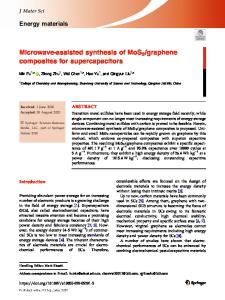Scalable salt-templated directed synthesis of high-quality MoS 2 nanosheets powders towards energetic and environmental
- PDF / 2,285,347 Bytes
- 7 Pages / 612 x 808 pts Page_size
- 66 Downloads / 226 Views
Scalable salt-templated directed synthesis of high-quality MoS2 nanosheets powders towards energetic and environmental applications Lijie Zhu, Pengfei Yang, Yahuan Huan, Shuangyuan Pan, Zhaoqian Zhang, Fangfang Cui, Yuping Shi, Shaolong Jiang, Chunyu Xie, Min Hong, Jiatian Fu, Jingyi Hu, and Yanfeng Zhang () Department of Materials Science and Engineering, College of Engineering, Peking University, Beijing 100871, China © Tsinghua University Press and Springer-Verlag GmbH Germany, part of Springer Nature 2020 Received: 13 May 2020 / Revised: 9 July 2020 / Accepted: 10 July 2020
ABSTRACT Two-dimensional (2D) transition metal dichalcogenides (TMDCs) have emerged as perfect platforms for developing applications in nano-electronics, catalysis, energy storage and environmental-related fields due to their superior properties. However, the low-cost, batch production of high-quality 2D TMDCs remains a huge challenge with the existing synthetic strategies. Herein, we present a scalable chemical vapor deposition (CVD) approach for the batch production of high-quality MoS2 nanosheet powders, by using naturally abundant, water-soluble and recyclable NaCl crystal powders as templates. The high-quality MoS2 nanosheets powders are achieved by a facile water dissolution-filtration process, by virtue of the excellent dispersibility of the as-grown products in water. The internal mechanism for the scalable synthesis strategy is explored. The applications of the MoS2 nanosheets powders are also demonstrated as catalysts or adsorbents in hydrogen evolution reaction (HER) and organic dyes adsorption, respectively. This work should hereby pave ways for the mass production and application of powdery TMDCs in energetic and environmental related fields.
KEYWORDS mass production, salt-templated, molybdenum disulfide, chemical vapor deposition, green transfer
1
Introduction
Recently, two-dimensional (2D) transition metal dichalcogenides (TMDCs) have opened new perspectives for engineering nextgeneration electronics, optoelectronics and catalysis, thanks to their unique physical and chemical properties different from their bulk counterparts [1–10]. In particular, monolayer or fewlayer molybdenum disulfide (MoS2), exhibits high catalytic activity [11–13], large specific surface area [14], together with excellent chemical stability [2] and nontoxicity properties [15, 16], making it a highly promising material for energy and environmental-related applications. To achieve this, large-scale production of high-quality MoS2 nano-sheets or powders is highly desired, while still challenging. So far, chemical exfoliation route through lithium intercalation is commonly utilized as a scalable method for the batch production of few-layer TMDCs with low cost [17–20]. However, this process usually involves intercalation-induced phase transformation (from 2H to 1T phase for MoS2 [18, 19]), and pristine property alternations. Moreover, due to the uncontrollable ion intercalation concentration and strain damage involved in the ion-intercalated MoS2 layer
Data Loading...











